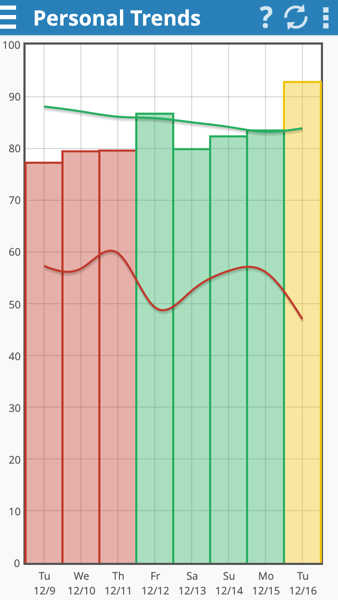How to Track HRV to Measure Progress
Written by Christopher Kelly
Dec. 16, 2014
Heart Rate Variability (HRV) is a neat way to track your readiness to train. Even if you're not a competitive athlete, HRV can show how you're making progress with your health over time. All you need is a Bluetooth compatible heart rate monitor and an app like EliteHRV. Jason Moore is the co-founder of EliteHRV, for more information, checkout our recent podcast.
Each and every morning I start the day by spending a few minutes paying attention to my breathing as I lie on the floor on my back. During this time, the heart rate monitor sends data to the app running my phone.
 The chart shown here is a snapshot of my HRV over the past week. The green line shows the general trend; higher is typically better. The red line is my heart rate. Each bar shows my HRV for that particular day.
The chart shown here is a snapshot of my HRV over the past week. The green line shows the general trend; higher is typically better. The red line is my heart rate. Each bar shows my HRV for that particular day.
The past couple of weeks have been unusual in that I've not been riding my bike regularly, and I've also just started strength training again for the first time in nine months.
The red bars on the chart show the days immediately following the strength training; it's easy to see how my nervous system responded. Thursday and Friday I spent just walking and by the weekend my HRV score bounced back into the mid-eighties.
At the weekend, I rode my bike for four hours on both days. Initially, this doesn't affect my HRV very much but by Tuesday there's a huge step up. Why would this be? Doesn't more training lead to a lower number? Not necessarily. This from Jason:
Part of what could be going on is that during periods of regular physical activity your body is very actively recovering on a regular basis which elevates Parasympathetic activity and HRV. When you take a long enough break from exercise your recovery systems can level out and have no need to raise a little higher in response to the training (a sign of a healthy nervous system).
Jason's narrative is consistent with the data here; a stronger parasympathetic tone is suppressing my resting heart rate shown as a red line.
If only I'd had this tool when I first started training for bike races. Back then, I would completely ignore any signs of fatigue and push on and on. Eventually, the parasympathetic tone would grow strong enough to suppress my heart rate down into the thirties at rest and 140s at tempo, a clear sign of overtraining in someone with a maximum heart rate of 190. At the time, I thought this meant I was getting faster as many coaches use heart rate at any given power output as a marker of fitness. The fitter you are, the lower the heart rate. True to a point.
If you're currently working with me, go ahead and get yourself setup with EliteHRV. Preventing overtraining is important, but I also want the data to show how you improve over time.
Register for instant access to your FREE 15-page book, What We Eat
© 2013-2025 nourishbalancethrive